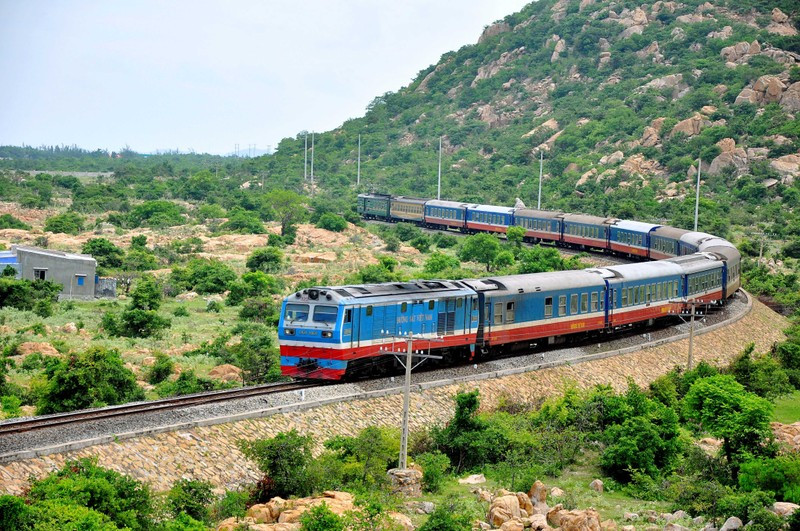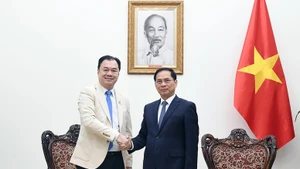This is an important legal framework for the management, investment and exploitation of railway infrastructure and transport business, in the direction of clearly demarcating between state management and business, ensuring fair and equal competition between economic sectors.
However, after five years of implementation, many new problems have arisen in practice, requiring the competent authorities to review and study to amend and supplement the provisions of the 2017 Railway Law, forming a strict policy framework, as well as creating a more favourable environment for investment and development of railway transport.
Investment has not been prioritised
The current situation of Vietnam's railway infrastructure is still backward, not synchronised, with low train speed, limited throughput capacity, and many level crossings that pose a potential risk of traffic insecurity. There is no synchronous connection with other modes of transport, as well as a lack of connection to inland ports, factories, and industrial parks.
Therefore, when the Railway Law took effect, there were regulations on prioritising the concentration of resources for investment, development, upgrading and maintenance of national and urban railway infrastructure and prioritising the allocation of central budget resources in the medium-term and annual public investment plans at an appropriate rate, to ensure railway development as planned.
However, according to the Deputy Director in charge of the Vietnam Railway Administration (the Ministry of Transport) Tran Thien Canh, the actual arrangement of investment funds for the construction of railway infrastructure has not met the demand.
Specifically, in the 2016-2020 period, the investment capital for railway infrastructure development arranged through the Ministry of Transport was 18.657 trillion, which only reached 8.19% of the demand.
By 2030, the planned capital demand will continue to need about 240 trillion VND, but so far, the state budget has only allocated 14.025 trillion VND for the 2021-2025 period, accounting for 5.8% of the demand.
On the other hand, the preferential mechanisms for capital mobilisation, although legalised (Article 6 of the Railway Law 2017), have not been implemented, leading to limited corporate capital and socialisation. Since the 2017 Railway Law came into effect, not a single km of national railway has been built so far.
Similarly, the financial source for the management and maintenance of railway infrastructure is allocated from the state budget's recurrent expenditure, although it has increased steadily over the years, but currently has only reached 40% of the total budget level.
Besides, the Railway Law 2017 also has regulations to encourage, support, facilitate and protect the legitimate interests of domestic and foreign organisations and individuals investing in railway business; preferential loans for investment in the procurement of railway means of transport; import tax exemption for machinery, spare parts and replacement equipment.
Regarding railway investment resources, state budget capital and ODA are still the main sources. Other capital sources such as socialisation, exploitation of the land fund around the station, and exploitation of TOD model, are only additional resources. Transport Minister Nguyen Van Thang
However, the specific regulations are governed by other laws that do not have regulations or that conflict with the Railway Law. Over the past five years, railway transport businesses have made great efforts to borrow nearly 2 trillion VND to upgrade and build new wagons, import spare parts, and improve the quality of transportation services. However, these enterprises have not yet enjoyed preferential policies following the provisions of the Law.
“It is clear that the thinking and awareness about the role, advantages, and necessity of prioritising investment in railway transport are not enough. We are lacking breakthrough mechanisms and policies to mobilise resources for the development and exploitation of railway infrastructure, especially urban railways and high-speed railways”, Deputy Director in charge of the Vietnam Railway Administration Tran Thien Canh.
Additional incentive mechanism
The railway, with its preeminent characteristics in terms of transport capacity and economic efficiency, plays a pivotal role in the national transport system.
But in fact, the volume of freight and passenger transport via rail has continuously decreased in recent years. The management and exploitation of railway infrastructure is inefficient and we have not yet created a competitive market to attract private investors to invest in railways.
It is necessary to amend and supplement the Railway Law in the direction of assigning more powers to the Provincial People's Committees, to organise investment in construction, management, maintenance and exploitation of railway infrastructure, to seek opportunities and possibilities to mobilise capital from localities; supplement the incentive mechanism for traffic connection-oriented urban development models (TOD - Transit Orient Development), to create attraction for many economic sectors to participate in railway development investment projects.
The experience of some countries in the world such as China and Japan has proved that TOD projects bring many benefits such as reducing the budget burden when investing in railway stations, thanks to the income from urban development or facilitating urban development.
Supporting the above proposals, Transport Minister Nguyen Van Thang also said, that the amendment of the Railway Law should supplement several regulations on policies, incentives and support for railway infrastructure development, railway transport and the railway industry.
Regarding the railway industry, functional agencies should prescribe policies to support investment in facilities, technological innovation, and development of railway mechanical products; build an ordering mechanism for several large-scale domestic corporations and enterprises, capable of performing strategic tasks, leading the modernisation process of the industry; at the same time, promote localisation, joint ventures and linkages between domestic enterprises and foreign enterprises, when investing in railway development.
Regarding high-speed railways, it is necessary to supplement specific regulations on investment, construction, management, maintenance, operation and exploitation; prescribe the coordination process in planning, and construction standards, as well as have mechanisms and policies to ensure financial resources and attract and encourage entities to participate in construction investment and business development in this field.
“However, regarding railway investment resources, state budget capital and ODA are still the main sources. Other capital sources such as socialisation, exploitation of the land fund around the station, and exploitation of TOD model, are only additional resources", Transport Minister Nguyen Van Thang noted.
















